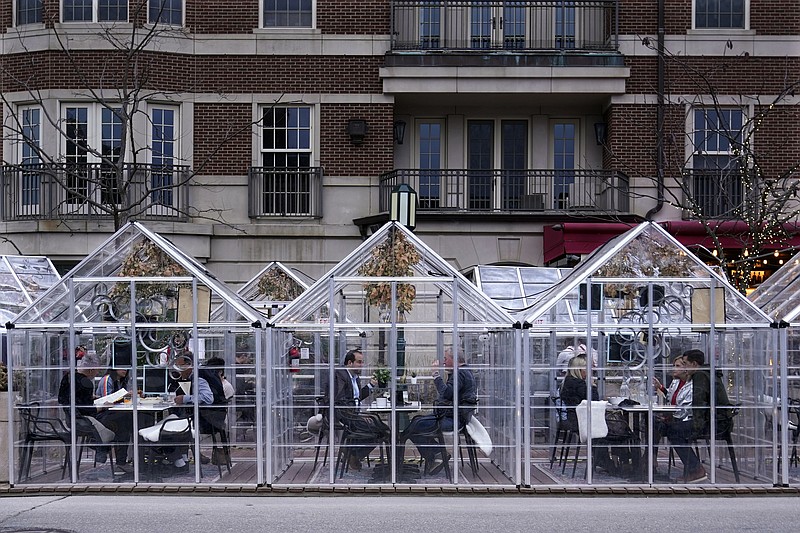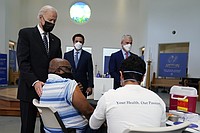Nearly half of new coronavirus infections nationwide are in just five states -- a situation that is putting pressure on the federal government to consider changing how it distributes vaccines by sending more doses to hot spots.
New York, Michigan, Florida, Pennsylvania and New Jersey together reported 44% of the nation's new covid-19 infections, or nearly 197,500 new cases, in the latest available seven-day period, according to state health agency data compiled by Johns Hopkins University. Total U.S. infections during the same week numbered more than 452,000.
The heavy concentration of new cases in states that account for 22% of the U.S. population has prompted some experts and elected officials to call for President Joe Biden's administration to ship additional vaccine doses to those places. So far, the White House has shown no signs of shifting from its policy of dividing vaccine doses among states based on population.
[Video not showing up above? Click here to watch » https://www.youtube.com/watch?v=q72zDfpjV7A]
Sending extra doses to places where infection numbers are climbing makes sense, said Dr. Elvin H. Geng, a professor in infectious diseases at Washington University. But it's also complicated. States that are more successfully controlling the virus might see less vaccine as a result.
"You wouldn't want to make those folks wait because they were doing better," Geng said. "On the other hand, it only makes sense to send vaccines to where the cases are rising."
The spike in cases has been especially pronounced in Michigan, where the seven-day average of daily new infections reached 6,719 cases Sunday -- more than double what it was two weeks earlier. Only New York reported higher case numbers. And California and Texas, which have vastly larger populations than Michigan, are reporting less than half its number of daily infections.
Though Michigan has seen the highest rate of new infections in the past two weeks, Democratic Gov. Gretchen Whitmer has said she does not plan to tighten restrictions. She has blamed the virus surge on pandemic fatigue, which has people moving about more, as well as more contagious variants.
"Taking steps back wasn't going to fix the issue," Whitmer said as she got her first vaccine Tuesday at Ford Field in Detroit, home of the NFL's Lions. "What we have to do is really put our foot down on the pedal on vaccines" and urge people to wear masks, keep their social distance and wash their hands.
Whitmer got the shot the day after Michigan expanded eligibility to everyone age 16 and older. She asked the White House last week during a conference call with governors whether it has considered sending extra vaccine to states battling virus surges. She was told all options were on the table.
In New York City, it's still challenging to get vaccination appointments. Mayor Bill de Blasio has publicly harangued the federal government about the need for a bigger vaccine allotment almost daily, a refrain he repeated when speaking to reporters Tuesday.
"We still need supply, supply, supply," de Blasio said, before adding, "But things are really getting better."
On the state level, Gov. Andrew Cuomo has not called publicly for an increase in New York's vaccine allotment, even as cases ticked up in recent weeks and the number of hospitalized people hit a plateau.
In New Jersey, where the seven-day rolling average of daily new infections has risen over the past two weeks, from 4,050 daily cases to 4,250, Democratic Gov. Phil Murphy said he is constantly talking to the White House about demand for the coronavirus vaccine, though he stopped short of saying he was lobbying for more vaccines because of the state's high infection rate.
Vaccine shipments to New Jersey were up 12% in the past week, Murphy said Monday, though he questioned whether that's enough.
"We constantly look at, OK, we know we're going up, but are we going up at the rate we should be, particularly given the amount of cases we have?" Murphy said.
In Florida, relaxed safeguards during a busy spring break season likely helped spread virus variants, said University of South Florida epidemiologist Jason Salemi. The state's seven-day average of daily new infections has exceeded 5,400, an increase of 20% in the past two weeks.
While many new infections appear to be among younger people, Salemi said he's worried about Florida's senior citizens. About 78% of residents age 65 and older have received at least one vaccine dose, but roughly 1 million more still have not gotten any shots.
"We seemingly have the supply," Salemi said. "Are these people not planning to get vaccinated?"
Talk of sending extra shots to some states comes at a time when the number of daily infections in the U.S. has fallen dramatically compared with a January spike after the holiday season. However, the seven-day average of daily infections has been rising slowly since mid-March.
The five states seeing the most infections stand out. As of Tuesday, 31 states were reporting seven-day averages of fewer than 1,000 new daily cases.
White House coronavirus coordinator Jeff Zients said Tuesday that more than 28 million doses of covid-19 vaccines will be delivered to states this week.
NOT AT FINISH LINE
The news came as Biden announced Tuesday that he's bumping up his deadline by two weeks for states to make all adults in the U.S. eligible for coronavirus vaccines. But even as he expressed optimism about the pace of vaccinations, he warned Americans that the nation is not yet out of the woods when it comes to the pandemic.
"Let me be deadly earnest with you: We aren't at the finish line. We still have a lot of work to do. We're still in a life-and-death race against this virus," Biden said in remarks at the White House.
The president warned that "new variants of the virus are spreading, and they're moving quickly. Cases are going back up, hospitalizations are no longer declining." He added that "the pandemic remains dangerous," and encouraged Americans to continue to wash their hands, socially distance and wear masks.
Biden added that while his administration is on schedule to meet his new goal of distributing 200 million doses of the vaccine during his first 100 days, it will still take time for enough Americans to get vaccinated to slow the spread of the virus.
But he expressed hope that his Tuesday announcement, that every adult will be eligible by April 19 to sign up and get in a virtual line to be vaccinated, will help expand access and distribution of the vaccine. Some states already had begun moving up their deadlines from the original May 1 goal.
"No more confusing rules. No more confusing restrictions," Biden said.
The president also said no one should fear mutations of the coronavirus that are showing up in the U.S. after being discovered in other countries. He acknowledged that the new strains are more virulent and more dangerous, but said "the vaccines work on all of them."
Biden also announced that 150 million doses of covid-19 vaccine have been shot into arms since his inauguration on Jan. 20. That puts the president well on track to meet his new goal of 200 million shots administered by his 100th day in office on April 30.
Biden's original goal had been 100 million shots by the end of his first 100 days, but that number was reached in March.
CHILDREN'S CASES
Separately, new U.S. research shows that most children with a serious inflammatory illness linked to the coronavirus had initial covid-19 infections with no symptoms or only mild ones.
The unusual post-infection condition tends to be milder in kids who were sicker with covid-19, although more than half of affected youngsters received intensive hospital care, according to an analysis by the CDC published Tuesday in JAMA Pediatrics.
The study represents the largest analysis to date on U.S. cases of multisystem inflammatory syndrome in children and bolsters evidence that it is a delayed immune response to covid-19. The study included almost 1,800 cases reported to the CDC from March 2020 through mid-January. Most were in kids younger than 15, but the study included up to age 20.
Upticks in cases have occurred two to five weeks after covid-19 peaks and have followed spread of initial infections from urban to rural areas, the researchers said. More recent CDC data indicate that there's another emerging peak in the pediatric condition consistent with that trend.
State-reported cases through March 29 totaled 3,185 and included 36 deaths, the CDC's website shows. State reports aren't always timely so it is uncertain how many U.S. children developed the illness since the study ended.
Most kids who had covid-19 don't develop the post-infection illness. Almost 3.5 million U.S. children and teens have tested positive for covid-19, according to data compiled by the American Academy of Pediatrics and the Children's Hospital Association.
The condition was first reported in Europe in late winter and early spring of last year. Some cases, especially those that follow silent, undiagnosed covid-19 infections, may be mistaken for Kawasaki disease, a rare condition that can cause red skin, swelling and heart problems.
Dr. Sean O'Leary, vice chairman of the pediatrics academy's infectious diseases committee, said the inflammatory condition typically causes children to become very sick very quickly, but that most "respond very well to treatment and the vast majority get completely better."
Treatments may include steroids and other medicines that can reduce inflammation.
VACCINE PASSPORTS
Meanwhile, Texas on Tuesday prohibited state agencies and any entities receiving public money from requiring so-called vaccine passports under an order issued by Gov. Greg Abbott.
The order comes almost four weeks after Abbott, a Republican, lifted a statewide mask mandate and other anti-pandemic restrictions in the second-largest U.S. state. It also follows a similar ban by Florida Gov. Ron DeSantis on the sort of Excelsior Pass launched in New York that allows residents to verify their vaccinations or negative test results before entering concert venues or stadiums.
In Tennessee, Gov. Bill Lee on Tuesday also advocated against covid-19 vaccine passports.
Currently, vaccine passports exist only in New York via a government-sponsored smartphone app produced in partnership with a private company.
"I think vaccine passports are a bad idea. I do not believe that government should impose vaccine requirements or mandates in any way," Lee told reporters, while urging the GOP-controlled General Assembly to advance legislation this year to prohibit such requirements.
Lee added that he hoped private businesses also don't impose vaccine passport mandates, but said that he doesn't believe "that government should impose itself in the private affairs of business practices." The version of the legislation advanced by a House subcommittee Tuesday does not preclude businesses from requiring vaccine passports on their own.
Lawmakers in Arkansas and Pennsylvania are considering similar measures.
Information for this article was contributed by Darlene Superville, David Eggert, Adriana Gomez Licon, Michael Catalini, Alexandra Jaffe, Sagar Meghani, Zeke Miller, Josh Boak, Lindsey Tanner, Kimberlee Kruesi and Jonathan Mattise of The Associated Press; and by Joe Carroll of Bloomberg News (WPNS).








